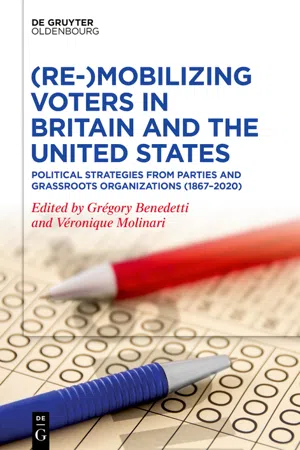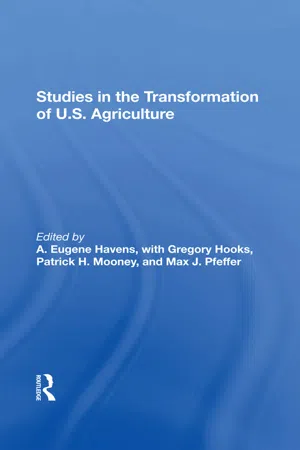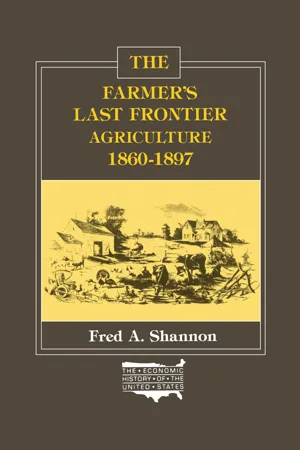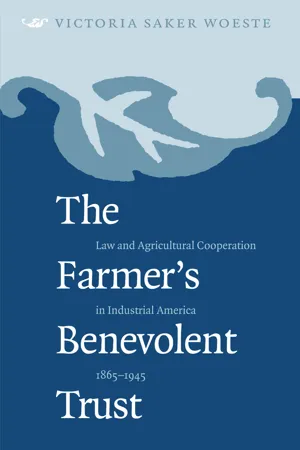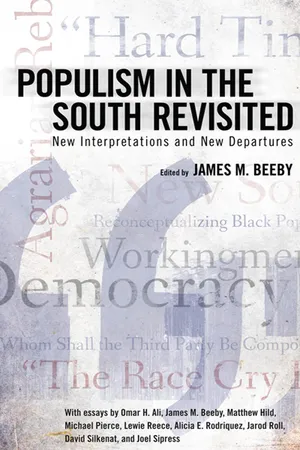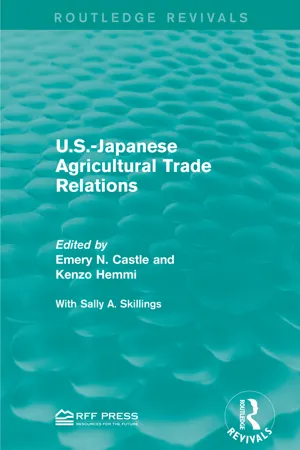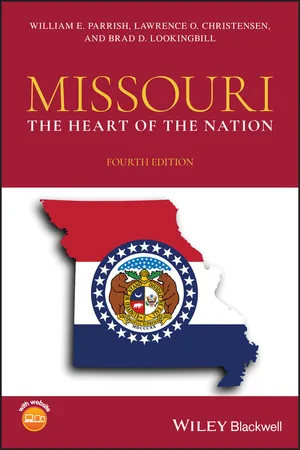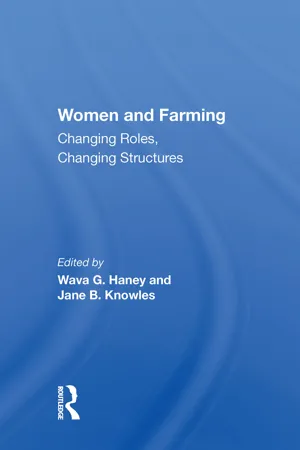History
Farmers' Alliances
Farmers' Alliances were grassroots organizations formed by American farmers in the late 19th century to address economic issues and advocate for agricultural reforms. These alliances sought to combat the power of big business and improve the economic conditions of farmers through collective action, including the establishment of cooperatives and political advocacy. The movement laid the groundwork for the later Populist Party.
Written by Perlego with AI-assistance
Related key terms
12 Key excerpts on "Farmers' Alliances"
- eBook - ePub
(Re-)Mobilizing Voters in Britain and the United States
Political Strategies from Parties and Grassroots Organisations (1867–2020)
- Gregory Benedetti, Veronique Molinari, Grégory Benedetti, Véronique Molinari(Authors)
- 2021(Publication Date)
- De Gruyter Oldenbourg(Publisher)
2All these alliances mobilised agrarians who were left behind in the march of progress, overpowered by corporations and financial institutions and geographically and historically marginalised by prospering urban centres in the northeast. The different alliances pushed for radical reforms (progressive income tax and government ownership of transport and communications to name but a few) in an attempt to curb the threat wealth concentration posed for economic and political freedom. The movement also attracted all sorts of middle-class reformers and radicals. At the beginning of the 1890s, Farmers’ Alliances entered politics and created the People’s Party, also known as the Populist Party. This study focuses on Farmers’ Alliances. However, since there is no clear-cut separation between the two movements, it also deals with the beginning of Populism.3 As the movement was in full swing in the 1890s, the 14 founders of the original Texas Alliance posed in front of the cabin where their first formal meeting was held in 1877 in Pleasant Valley, Lampasas County, Texas.4 How did a movement that started with a dozen farmers eventually mobilise millions of Americans? The article will examine the strategies, tools and institutions Alliances used to mobilise their constituency and study one militant group that was particularly galvanised into action – women. The political and intellectual history questions raised by the “agrarian uprising” – discussed most notably in Charles Postel’s recent re-evaluation of Populism – will be considered from a double perspective: the sociology of social movements and book and periodical studies.5 - eBook - ePub
- Immanuel Ness(Author)
- 2015(Publication Date)
- Routledge(Publisher)
Perhaps the enduring lesson that farmers learned from the Alliance was that a mix of self-help, lobbying, and political pressure on the two major parties worked best in the long run. The third-party venture that killed both the Farmers' Alliance and Populist Party proved a dead end.The later successes of the National Farmers Union (formally called the Farmers Educational and Cooperative Union of America) best illustrate this point. This third mass-farmers' organization in American history was established near Point, Texas, in 1902. The movement initially experienced phenomenal growth with a membership of 120,000 in 1910 and over 140,000 in 1919, mostly in the Gulf States but eventually spreading to the Midwest and Far West. Following in the footsteps of the Grange and the Alliance, the union promotes cooperative warehouses, grain elevators, stores, and grain and corn mills, establishes plants for manufacture of farm products, and advocates diversification in the production of agricultural commodities, good farm-to-market roads, and improved farm management techniques. These essentially economic and social reforms have been balanced with effective lobbying of the two political parties for programs and public policies to benefit farmers.James H. ConradBibliography
Barnes, Donna A, Farmers in Rebellion: The Rise and Fall of the Southern Farmers Alliance and People's Party in Texas . Austin: University of Texas Press, 1984.Goodwyn, Lawrence. Democratic Promise: The Populist Movement in America . New York: Oxford University Press, 1976.Hicks. John D. The Populist Revolt: A History of the Farmers' Alliance and the Populist Party . Minneapolis: University of Minnesota Press, 1931.Hofstadter, Richard. The Age of Reform: From Bryan to FDR . New York: Knopf Publishing Group, 1976.McMath, Robert C., Jr. Populist Vanguard: A History of the Southern Alliance . Chapel Hill: University of North Carolina, 1975.Schwartz, Michael. Radical Protest and Social Structure: The Southern Farmers' Alliance and Cotton Tenancy, 1880-1890 - eBook - ePub
- James L. Hunt(Author)
- 2003(Publication Date)
- The University of North Carolina Press(Publisher)
2 AN ALLIANCE EDUCATION
WHILE MARION BUTLER established himself as a popular educator, some southern farmers began a political revolt. Declining crop prices, scarce money, high interest rates, lack of affordable credit, high transportation costs, and expensive manufactured goods protected by tariffs appeared as tangible symptoms of an unjust economy. More broadly, these farmers feared that the rural way of life, so revered in Jeffersonian rhetoric, was no longer preeminent. Yet neither economic depression nor a perceived decline in rural importance produced the agrarian movement of the 1880s. More important was a political confidence that something could be done to make things better. For southerners, the primary vehicle of hope was the National Farmers’ Alliance and Industrial Union. Under the leadership of Charles W. Macune of Texas, it promoted cooperative marketing of agricultural products, encouraged scientific farming, and demanded legislation reducing the power of corporations, especially railroads and national banks. The Texas Alliance was an all-white secret union that restricted membership to farmers, workers, country doctors, and teachers. Lawyers and merchants, representatives of urban and corporate greed, could not join. The order arranged itself in a hierarchical manner, with a local “sub-Alliance” composed of ten to fifty members as the basic unit. Above the sub-Alliances were county Alliances, state Alliances, and national Alliance organizations.1By the mid-1880s many North Carolina farmers, especially small and middling landowners, were complaining about declining prices for land, cotton, and tobacco, expensive credit, and high transportation and marketing costs. They feared losing their land for taxes or debts, growing increasingly resentful of the booming prosperity of North Carolina manufacturers, especially in the tobacco industry. They felt threatened by urbanization, as the promise of excitement and economic opportunities lured youth from the countryside. From the outset, some of their anger was directed at the state legislature, which appeared wholly unsympathetic to their problems.2 - A. Eugene Havens, Gregory Hooks, Patrick H Mooney, Max Pfeffer(Authors)
- 2019(Publication Date)
- Routledge(Publisher)
As economic strategies were tried and failed, the farmers turned increasingly to the political arena, hoping to find solutions to their grievances there. The repeated frustrations of the farmers’ movement to address the structural inequalities they experienced ultimately led them to place demands on the state as the only agent that could regulate and transform structural relations. Initially Alliance members worked through existing parties or small independent parties to put pressure on legislators. Eventually, however, the Northern Alliance sought independent, third-party action to capture the state machinery, after having been disappointed time and again by the existing parties. In the South, control of the Democratic party was the strategy. The elections of 1890 were a tremendous victory for the Alliance in both the North and the South. Alliance candidates won positions in local, state and national elections. However, due to the inexperience of the elected farmers, the strength of the opposing lobbies, and the power of the traditional party machines, the Alliance programs were only partially realized through legislation. The program had been pushed on a local and state-wide basis, and its failure pointed the way towards a national third party organization that could coordinate efforts and exert real clout at the level of national politics (Hicks, 1961).During the 1890s farmers expanded the social base of their movement by taking a major role in organizing the People’s Party, giving rise to what came to be known as the Populist Movement. Present at the founding convention of the party were the National Farmers’ Alliance and Industrial Union (246 delegates), the National Farmers’ Alliance (97 delegates), the National Colored Alliance and Cooperative Union (97 delegates), the Knights of Labor (82 delegates), and several smaller delegations with 25–50 additional delegates (Hicks, 1961:226). The American Federation of Labor refused to ally with the party, which contained “employing farmers.” The first party platform endorsed government ownership of railroads and telephone and telegraph lines. It also demanded that railroads and other corporations return lands to the government that were not being used by them, and it condemned alien ownership of land. It sought the unlimited coinage of silver, a graduated income tax, savings banks, shorter hours for labor, direct election of U.S. Senators, and single terms for the President and Vice-President. The “Populist” vote was strong in the 1892 and 1894 elections, but by 1896 the silver issue had become primary, and the party fused with the Democratic party in support of the election of William Jennings Bryant. Farmers began to lose interest in the party, which struggled along weakly until the 1904 election (Hicks, 1961).- James R. Stone Jr.(Author)
- 2022(Publication Date)
- Routledge(Publisher)
Nearly everywhere Alliance lecturers went, according to Goodwyn, they met with an enthusiastic reception from farmers who, even if, as in the upper Midwest, the plains, and the West, they were not suffering under the crop lien system, did face exorbitant interest rates charged by banks to get credit to buy land and necessary farming equipment as well as livestock. As a consequence of these high interest rates, 45 percent of the land in Kansas had come under the ownership of banks by the late 1880s (Judis, 2016, p. 23). The problem of lack of credit and high interest rates was made worse by the gold standard in tandem with a decline in the supply of gold and the stranglehold on the credit system exercised by the eastern banking establishment. In addition, farmers received ever lower prices for their crops from year to year and decade to decade as crop prices fell two-thirds in the Midwest and South from 1870 to 1890 (Judis, 2016, p. 22). They were also forced to pay excessive shipping rates to railroad companies that charged large commercial interests shipping longer distances a lower rate, but in many cases forced small farmers to pay a “transit rate” equivalent to the cost of shipping to the rail line’s most distant terminal even if the farmer only wished to ship over a portion of the line (Goodwyn, 1978, pp. 69–70). These practices led the Populists to view the railroads and the banks as malign industries that exploited them and then used the accumulated wealth to corrupt both the federal and state governments.Though farmers originally sought to escape the economic hardship and injustices that they faced through the Farmer’s Alliances and cooperatives they founded, they soon discovered that the Alliance movement, like the Grange, was insufficient to counter the power of the commercial interests they were up against. Charles Macune, the first President of the National Farmers Alliance and Cooperative Union, promoted rapid expansion of the Alliance and he came up with several creative schemes that aimed to solve the essential problem that Alliance farmers believed they were up against, which was lack of capital and credit. The sub-treasury note plan involved land-owning farmers in the Texas Alliance placing their entire individual holdings at the disposal of the Alliance to use as collateral to obtain credit to purchase supplies for all of the farmers (land-owning as well as landless tenant farmers and sharecroppers) who were members of the Alliance. As collateral for putting up their land, the land-owning farmers within the Alliance would receive mortgages on the crops of the landless farmers. All Alliance farmers “would collectively purchase their supplies for the year through the Texas State Exchange on credit,” the landowners signing a joint note, and they would market their crops collectively through the exchange and then pay off the joint notes at the end of the year. Macune also proposed the “creation of a treasury within the exchange to issue its own currency” which could be used “in payment of up to 90 per cent of the current market value of commodities.” Farmers would be able to use this currency to purchase their supplies at the cooperative Alliance stores (Goodwyn, 1978, pp. 75 & 81).- eBook - ePub
The Farmer's Last Frontier
Agriculture, 1860-97
- Fred A. Shannon(Author)
- 2017(Publication Date)
- Routledge(Publisher)
Though the Grange dropped out of sight as a political force after the late 1870’s, farmers’ clubs continued their activities and tended to coalesce into alliances. In 1874 or 1875, Lampasas, Texas, had an alliance for catching horse thieves, recovering estrays, and buying supplies. It was a secret society which also fought land monopolists and the big cattlemen who were inclined to ignore the rights of small competitors. This idea soon spread to other counties and, in 1878, a Grand State Alliance was organized, only to be all but killed by dissensions over greenbackism. Revival was rapid, and in 1880 a new Grand State Alliance was incorporated by the state, as a benevolent society of a secret nature. By 1885, it claimed 1,200 lodges and 50,000 members. It fought against low prices, crop liens, and the oppression of the country merchants. By 1886, it was beginning to demand higher taxes on speculative landholdings, a ban on alien landowning, laws against dealing in futures, higher taxes on railroads, more paper money, and other issues later absorbed by the Populist party. These demands caused threats of further schism; whereupon C. W. Macune stepped forward, saved the Alliance, and started a movement for combination with other groups throughout the South.The largest of all these rivals started in Arkansas, in 1882, as a debating society, and in 1883 took the name of the Agricultural Wheel. By the processes of absorption and expansion, the Wheel extended into eight states by 1887, and claimed half a million members. The merger of the Alliance and the Wheel was effected in 1889, under the temporary compromise name of the Farmers’ and Laborers’ Union. Lawyers, merchants and their clerks, and stockholders in banks or stores of other than the cooperative variety were denied membership. By 1890, the enlarged society had a membership of over a million.38 Working in close sympathy with this alliance were the Fanners’ Clubs fostered by Benjamin R. Tillman in South Carolina.39During these same years, the farmers of the Northwest were also active in organization. The National Farmers’ Alliance, commonly called the Northwestern Alliance, may have had some generic connection with an alliance of Grangers in New York, uniting for political purposes, in 1877. The latter may have got the idea from a Settlers’ Protective Association started in Kansas in 1874, to help squatters in their fight against the railroad land monopolies. Such are the claims, though slightly overwrought. But it was Milton George of Chicago, editor of the Western Rural, who in 1880 established the alliance that, within two years, was to claim 2,000 local groups with 100,000 members. This organization followed on the heels of two or three years of hard times in the Prairie states. As conditions improved, in 1883 and 1884, interest lagged. Then, following low wheat prices in 1884-1885, membership picked up in all the wheat states of the Northwest, and by 1887 the Northwestern Alliance was beginning to demand such things as federal competition with railroads and the revival of free coinage of silver. In the Minneapolis convention of that year, there was some tendency to cooperate with the Knights of Labor. By 1890, the Midwest farmers were thoroughly class conscious. Kansas claimed 130,000 alliance members, while Nebraska, the Dakotas, and Minnesota were close rivals. The organization had already spread through fifteen states, and was reaching out for more.40 - eBook - ePub
Studies in Legal History
Law and Agricultural Cooperation in Industrial America, 1865-1945
- Victoria Saker Woeste(Author)
- 2000(Publication Date)
- The University of North Carolina Press(Publisher)
16Although leaders such as Macune spoke in Rochdalian terms, and notwithstanding the Alliance’s political kinship with “labor radicalism and Green-backer ideology,” the Populists did little more than use cooperation as a rallying cry. Like the Grange before it, the Farmers’ Alliance was unable to produce cooperatives that were commercially viable for more than a few years. They failed in part because they lacked sufficient capital and credit and in part because of the political emphases of the protest movements. Instead of focusing on exclusive service to members and devising organizations to address specific marketing problems, which varied among crops and regions, Granger and Alliance cooperatives aimed high, attempting to replace manufacturers in the 1870s and bankers in the 1880s.17Moreover, rank-and-file farmers learned through the failure of these organizations the difference between cooperative ideology and economic function. While both Granger and Populist leaders relied heavily on cooperative ideology, they assumed that the Rochdale model, which had been devised for collective purchasing, could be used for marketing without much modification. That was a critical misjudgment. Designed for collective purchasing, Rochdale cooperatives restricted their clientele and their business to a volume that members’ pooled capital could support. The restriction on capital stock was the very feature that supposedly distinguished it from profit-making corporations. Collective marketing, in contrast, required large outlays of capital well in advance of actual returns. This need grew in proportion to the scale of marketing operations. Regional or national operations required larger investments of capital, skill, management, communications, and other inputs. If farmers decided to begin or continue their collective action at the processing stage, they needed money to buy or build these facilities. Limited by statute to nominal amounts of capital stock, Rochdale cooperatives did not possess the resources necessary to undertake these activities. The Granger and Alliance organizations testified to this limitation even as they expanded Rochdale’s political and ideological appeal.18 - eBook - ePub
Populism in the South Revisited
New Interpretations and New Departures
- James M. Beeby, James M. Beeby(Authors)
- 2012(Publication Date)
- University Press of Mississippi(Publisher)
4Since the 1990s, historians have started to look more closely at the relationship between organized workers and the People’s Party, finding far more cooperation than the earlier studies suggested. Most of this work has focused on the activities of organized workers within specific localities or regions, and no region has received as much attention as the South. Building on the work of Daniel Letwin, Karen Shapiro, and Alicia Rodriquez, Matthew Hild has recast the way that historians understand southern Populism, finding widespread support for the People’s Party among organized labor in the South, especially the Knights of Labor. Historians no longer attribute the failure of southern Populism to a lack of support from the labor movement or the inability to bridge the farmer-worker divide. This essay complicates the growing consensus. Leaders like Watson may have at times accepted the support of the relatively small number of organized workers within the South, men who could help win close elections at the local and state level and would always be relegated to secondary roles in party matters, but they did not feel the same way about trade unionists from the Industrial Midwest or other regions who joined the party, men who at times refused to play second fiddle to the party’s agrarian leadership and did nothing to help southern or western Populists at the polls.5 - eBook - ePub
- Emery N. Castle, Kenzo Hemmi, Sally A. Skillings(Authors)
- 2015(Publication Date)
- Routledge(Publisher)
r ar) have always overcome these movements by absorbing the main planks of their platforms into their own, and thereby diminishing the passions of fear and hatred which had given them birth. Historically, low farm prices breed rural populism; good farm prices dissipate the discontent, whereupon the people's movement would fail, or mature and be transformed into an interest group. Such seems to have been the almost relentless cycle of agrarian populist movements.Now the rise of the American Agriculture Movement ( AAM) in the late 1970s has proved, once again, that a resurgence of bitter deep-seated farmer discontent will manifest itself in the form of another, this time quite unusual, populist movement. The use of expensive farm tractors to block the Fourteenth Street Bridge leading to the huge South Building, which houses a major portion of the U.S. Department of Agriculture's (USDA's) bureaucracy, and to nearly cordon off access to the U.S. Capitol and the House and Senate office buildings, constituted a remarkable scene in the nation's capital. But these actions—along with camping on The Mall, piling corn on Independence Avenue where it fronts on to the agriculture department's administration building, and invading the secretary's office of that department—proved that the spirit of populism is still alive in rural America. Moreover, these moderately radical tactics were not in vain. A bewildered Department of Agriculture and a beleaguered Congress responded. Populist-based tactics were also clearly influential in the passage of the Emergency Agricultural Act of 1978 (I... Mayer, 1978).It is a reasonable, though debatable, thesis that the tanner interest groups of today are offspring of the populist movements of yesteryear. Today's National Grange is a modest shadow of the radical Grange movement of the 1870s. The present National Farmers Union (NFU) is not the firebrand it was in the first half of this century. Major sections of the cooperative movement have been organized into a business-minded, establishment-oriented confederation, the National Council of Farmer Cooperatives. The National Farmers Organization (NFO) burst into prominence in the late 1950s. Caused by low farm prices and motivated by the desire to establish countervailing power, it was willing to use radical tactics to try to make effective its holding-action strategy. In recent years, however, the NFO has become more moderate in its demands and business oriented in its procedures. Now the AAM seems to be in the process of transforming itself from a radical to a liberal interest group, in terms of its demands and strategies. - eBook - ePub
Liberty and Coercion
The Paradox of American Government from the Founding to the Present
- Gary Gerstle(Author)
- 2017(Publication Date)
- Princeton University Press(Publisher)
In the country’s larger industrial sector, New Dealers proved more successful in redistributing economic resources and political power from the rich to the poor. Still, the agricultural economy was in the vanguard of New Deal reform, and that is where an analysis of 1930s’ changes in governance must start.POPULIST ANGER AND THE RISE OF AN AGRICULTURAL STATEExamining the arc of agrarian protest and government responses from the 1880s on will help us grasp both the possibilities and limits reformers faced in the 1930s. The waves of agrarian protests that culminated in the Populist challenge of the 1890s had posed acute challenges to the established economic and political order. While Populism as a formal organized protest failed, the fears it generated compelled government authorities to find ways to ameliorate the conditions of farmers, if only to forestall another mass agrarian uprising. These are the circumstances that spurred one of the most surprising developments in the history of American government: the transformation of a bureaucratic backwater, the United States Department of Agriculture (USDA), into an innovative and capacious institution of domestic governance in the first three decades of the twentieth century.Mass agrarian protest began with 750,000 farmers who joined one of the 19,000 chapters of the Grange in the 1870s, and culminated in the millions in the South and Midwest who joined the Farmers’ Alliance and then the People’s Party in the 1890s. Corporate power of many sorts disturbed the agrarians, but none as much as that exercised by the railroads, with their outsized influence on legislative bodies and their ability to charge discriminatory shipping rates to small and isolated farmers who were served by only one railroad. The railroads, it was commonly charged, constituted a “monopoly,” and were using the privileges granted to them by the government to abuse the public good.5As agrarians took their protests into politics, they initially thought that putting forward their own candidates to run against the railroad candidates for Congress and statehouses would be enough to achieve their goals. When this proved insufficient, they attempted to reform politics by minimizing opportunities for backroom dealing, chiefly by proposing laws to make elections more honest and the links between individual voters and their representatives more direct. Several of the most important political reforms of the late nineteenth and early twentieth centuries emerged from the ranks of agrarian protesters. These included the adoption of the Australian (secret) ballot, direct election of US senators (1913), and the initiative and referendum. Already in the 1890s, however, it had become clear that these reforms were insufficient to end the reign of capital. The Populists began calling on the central government to expand its reach and intervene in the economy on the farmers’ behalf.6 The campaign to put “the people” in charge of the US government lay at the heart of the People’s Party insurgencies of 1892 and 1896. “We believe,” declared their 1892 platform, “that the power of government—in other words, of the people—shall be expanded” so that “oppression, injustice, and poverty shall eventually cease in the land.”7 The platform called for the central state to take over the railroads and telegraph lines, and to operate them in the people’s interests. It also called on the federal government to combat the vicissitudes of the agricultural and currency markets by building and operating a vast loan and crop storage system that would sell crops at opportune moments (as measured by movements in world crop prices), and extend credit to farmers who would be without income until those crops could be sold.8 The Populists somewhat clumsily labeled this system the “sub-treasury plan.” But they were hardly clumsy in declaring their intention to build a central state large and powerful enough to manage the transportation, communication, and agricultural sectors of the American economy in the public interest. The need to contain the power of the corporations, defuse social conflict, and stabilize the economy, the Populists argued, demanded nothing less.9 - eBook - ePub
Missouri
The Heart of the Nation
- William E. Parrish, Lawrence O. Christensen, Brad D. Lookingbill(Authors)
- 2019(Publication Date)
- Wiley-Blackwell(Publisher)
12 Angry Farmers and Urban ReformersAs a steel web of railroads wove the nation together, farmers writhed in economic distress. They watched wheat prices fluctuate from one dollar per bushel in 1870 to 43 cents per bushel in 1890. Corn prices ranged from 45 cents per bushel in 1870 to 20 cents per bushel in 1890. Banking policies that increased interest rates added to the cost of borrowing during the agricultural expansion. Government policies that manipulated the currency by recalling paper money and ending the coinage of silver worsened the plight of debtors. While the forces of consolidation in Missouri seemed to work to the advantage of corporations, farmers struggled to pay debts with deflated dollars and declining prices.Figure 12.1Commissioner’s official railway map of Missouri, 1888. State Historical Society of Missouri.Background to Populism
Farmers responded to the adverse conditions by forming cooperatives, which called for government regulation of railroads. They began to act under the auspices of the National Grange, which was the first significant farmer organization in the United States. Oliver H. Kelly, a former clerk in the federal Bureau of Agriculture, founded the Grange in 1867 and started it in Missouri in 1870. Five years later, it claimed more chapters in Missouri than in any other state. As the Grange developed, members divided over the direction that the farm movement should take. Some advocated greater activism, while the majority advised continued concentration on social and educational uplift. Populism represented a mode of political discourse that highlighted the contrast between the “the people” and “the elites,” frequently accusing the latter of abusing the former in the late nineteenth century.Third Parties
The People's party of 1874 arose in response to the power of railroads. Its failure to unite the farm vote illustrated a problem that would persist in Missouri throughout the century. Dying after only one election, the People's party found successors in the Greenback and Union Labor parties. They placed candidates on the ballot in every Missouri election between 1876 and 1888. Taking their name from the federal paper notes issued during the Civil War, the Greenbackers advocated the issuance of notes as legal tender, a federal tax on incomes, an eight‐hour day law for labor, equal pay for each sex, and the availability of public lands to actual settlers only. Greenbackers polled their largest number of votes in 1880 with 36,338 for governor, still less than 10% of the total. Adhering to the same principles and including many former Greenbackers among its leaders, the Union Labor party ran candidates in 1888 and 1890. At times the third parties fused with Republicans in local and statewide elections, albeit with limited success. - eBook - ePub
Women And Farming
Changing Roles, Changing Structures
- Wava G Haney(Author)
- 2021(Publication Date)
- Routledge(Publisher)
American Nonconformist, a newspaper widely read by radical Populists and published in Indianapolis, printed several hundred such letters from children in the months prior to the 1892 presidential election. These letters and several other factors indicate the extent to which the National Farmers' Alliance and the Populist Party in the late 1880s and early 1890s encouraged the participation of women, children, and entire families in the political process. By focusing on the period immediately preceding and following the 1892 elections, one sees clearly the influence of women in the Populist Party and especially the interest which children took in the political process. The origins of the People's Party were rural and given the nature of family farming in which all members of a family worked at farming, it is not unusual that entire families would then enter into politics. As the Party became more determined to win on a national level and as a consequence willing to compromise with the Democratic Party, it, not surprisingly, began neglecting its commitment to agrarian reforms. Grass roots support became less significant, and women's participation dwindled as men perceived women's interests, if not their outspokeness, as threatening.FAMILY POLITICS: THE RECRUITMENT OF CHILDREN
Although most recent historians of Populism have ignored women and children in their studies of the Alliance and People's Party, Populist novelists of the late nineteenth century did document family particpation. Both Hamlin Garland and Fannie McCormick described Alliance and Populist gatherings. Garland's romantic and optimistic novel A Spoil of Office, published in 1892, tells of young Bradley Talcott, his conversion to reform politics, his romance with an Alliance woman orator (who was modeled after Mary Elizabeth Lease, the best-known female Populist orator), and his political campaign. While teaching Talcott the elements of reform politics, one of the politicians explains to Garland's hero some of the ways in which women and children are involved in politics. "See that old woman in the sunbonnet carrying that banner! Now don't make no mistake; the old girl knows just what that means; that's right! They're all reading these days, even the babies."3
Index pages curate the most relevant extracts from our library of academic textbooks. They’ve been created using an in-house natural language model (NLM), each adding context and meaning to key research topics.
